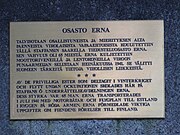The Erna long-range reconnaissance group (Estonian language: Erna luuregrupp ) was a Finnish Army formation, of Estonian volunteers, that fulfilled reconnaissance duties in Estonia behind the Red Army lines during World War II. The unit was formed by Finnish military intelligence with the assistance of German military intelligence for reconnaissance operations.[1]

Reconnaissance group Erna memorial plaque in Espoo, Finland
Formation of the Erna platoon[]
After the Soviet occupation of Estonia in 1940 hundreds of Estonian men fled to Finland rather than accept Soviet rule. The Estonian military attaché in Finland, Major Aksel Kristian, in the spring of 1941 had compiled a list of Estonians in Finland who wanted to liberate their homeland. Finnish intelligence subsequently recruited 15 volunteers and began training them on the island of Staffani in the region of Espoo.
On 22 June 1941 Nazi Germany invaded the Soviet Union.[2] Finland’s entering the war on the German side was only a matter of days, and all Estonians, living in Finland were being assembled in Helsinki in order to establish a voluntary unit for going to Estonia.[2] The platoon commander was colonel Henn Ants Kurg [2] of the Estonian Army, who had been the last Estonian Military Attaché to France.
Germans gave the group its name “Erna",[2] and two German liaison officers - oberleutnant Reinhardt and Sonderführer Schwarze - had also joined the group.[2] Erna was armed by and wearing the uniform of the Finnish army.[3] The two Germans in charge wanted ERNA to pledge allegiance to the Führer. However, colonel Henn Ants Kurg strongly opposed this.[2] He insisted that they were not Germans but Estonian volunteers, ready to co-operate, but without any commitments to Hitler.[2] After lots of disputes an agreement was reached that being in the service of the Finnish army, ERNA shall give the oath of loyalty to Finland. Accordingly, on 24 July 1941, the 15 specially trained men and 52 volunteers took an oath of allegiance to Finland.[2]
Action[]
On the night of 10 July the platoon made a seaborne landing on the northern coast of Estonia with 42 men arriving onshore and hiding in the Kautla Marshes 60 km south east of Tallinn. Another 17 team members were parachuted in on 28 July. The group's task was to perform reconnaissance deep behind Red Army lines for the Finnish Army but it turned to saving around 2,000 civilians hiding in the Kautla woods by allowing them to escape while the outnumbered Erna force engaged Soviet NKVD Destruction Battalions in a fierce battle on 31 July to 1 August 1941.[4] On 4 August, the platoon was ordered to cross the frontline and terminate their activities. A total of 32 men were lost, either killed or missing in action.[5]
Aftermath[]
A battalion (attached to 311 Infantry regiment of German army) was formed from the remnants of the original Erna platoon, with an additional 400 men, and dubbed "Erna II", but was subsequently disbanded on 10 October 1941. With the end of the war a number of the original members of Erna continued guerrilla activities, becoming Forest Brothers (Baltic partisans).[6] (Veterans of the Erna group were only a small fraction of the whole Forest Brothers resistance movement.)
Soviet historiography[]
Since the era of Stalin, Soviet propagandists have been making counterfactual assertions of the original Erna team having participated in mass murder of Soviet political activists. Sometimes, the myths also claim that the letter 'E' was cut onto the backs of the victims.
These claims were reinvigorated in the 1980s as a way of distracting historians analysing the Kautla massacre, and have been repeated in Russian media in 2000s.[7]
The Russian Federation's original position incorrectly classifies the members 'Nazis'.[8] Russian authorities regard the commemorative Erna retk as a “Nazi orgy” (ibid.).
See also[]
- Erna Raid, a yearly international military competition that commemorates the group's activities
References[]
- ↑ Estonian Citizens in the German Armed Forces. Volunteers, Conscripts and Commandeered Troops
- ↑ 2.0 2.1 2.2 2.3 2.4 2.5 2.6 2.7 Jõgi, Ülo. "Birth of the ERNA-organization and its operations in 1941". ERNA Society. http://www.erna.ee/en/?Erna_History/Birth_of_the_ERNA-organization. Retrieved 2007-08-10.
- ↑ C. Jurando, N Thomas PhD: Germany's Eastern Front Allies(2): Baltic Force, page 5. Osprey Publishing, 2002, ISBN 1-84176-193-1
- ↑ p16, Mart Laar: War in the Woods: Estonia's Struggle for Survival, 1944-1953. Howells House, 1991, ISBN 0-929590-08-2
- ↑ pp. 170-172, Formation of the Erna Platoon, Estonian State and People in World War 2, Volume 5, Stockholm, 1957
- ↑ p147, Mart Laar: War in the Woods: Estonia's Struggle for Survival, 1944-1953. Howells House, 1991, ISBN 0-929590-08-2
- ↑ Mart Laar: Tavaline stalinism, printed in Postimees 16 August 2007
- ↑ see e.g. Russian MFA Information and Press Department Commentary Regarding New Facts of Heroization of Nazism in Estonia (link)
The original article can be found at Erna long-range reconnaissance group and the edit history here.